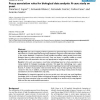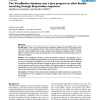BMCBI
2008
13 years 11 months ago
2008
Background: Last years' mapping of diverse genomes has generated huge amounts of biological data which are currently dispersed through many databases. Integration of the info...
BMCBI
2008
13 years 11 months ago
2008
Background: The power of haplotype-based methods for association studies, identification of regions under selection, and ancestral inference, is well-established for diploid organ...
BMCBI
2008
13 years 11 months ago
2008
BMCBI
2008
13 years 11 months ago
2008
Background: Viruses of the Bunyaviridae have segmented negative-stranded RNA genomes and several of them cause significant disease. Many partial sequences have been obtained from ...
BMCBI
2008
13 years 11 months ago
2008
Background: Microarray techniques are one of the main methods used to investigate thousands of gene expression profiles for enlightening complex biological processes responsible f...
BMCBI
2008
13 years 11 months ago
2008
Background: We consider effects of dependence among variables of high-dimensional data in multiple hypothesis testing problems, in particular the False Discovery Rate (FDR) contro...
BMCBI
2008
13 years 11 months ago
2008
Background: DNA microarray technology allows for the measurement of genome-wide expression patterns. Within the resultant mass of data lies the problem of analyzing and presenting...
BMCBI
2008
13 years 11 months ago
2008
BMCBI
2008
13 years 11 months ago
2008
Background: DNA microarray technology has emerged as a major tool for exploring cancer biology and solving clinical issues. Predicting a patient's response to chemotherapy is...
BMCBI
2008
13 years 11 months ago
2008
Background: Modern sequencing technologies allow rapid sequencing and bioinformatic analysis of genomes and metagenomes. With every new sequencing project a vast number of new pro...


